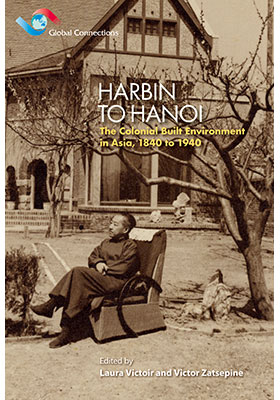Harbin to Hanoi
The Colonial Built Environment in Asia, 1840 to 1940
(從哈爾濱到河內:亞洲的殖民地建築環境,1840–1940)
ISBN : 978-988-8139-42-2
January 2013
304 pages, 6″ x 9″, 24 color and 26 b&w illus.
Ebooks
Also Available on
Colonial powers in China and northern Vietnam employed the built environment for many purposes: as an expression of imperial aspirations, a manifestation of supremacy, a mission to civilize, a re-creation of a home away from home, or simply as a place to live and work. In this volume, scholars of city planning, architecture, and Asian and imperial history provide a detailed analysis of how colonization worked on different levels, and how it was expressed in stone, iron, and concrete. The process of creating the colonial built environment was multilayered and unpredictable. This book uncovers the regional diversity of the colonial built form found from Harbin to Hanoi, varied experiences of the foreign powers in Asia, flexible interactions between the colonizers and the colonized, and the risks entailed in building and living in these colonies and treaty ports.
“This volume tells a complex story of conflict, collaboration and co-habitation between actors involved in the unevenness of colonial cities. Central to the volume is architecture and urban form seen as both the text and context for the enactment of power, negotiation and resistance. The contributors have done an excellent job in delivering an interpretive framework that understands colonial cities as a specific site of contestation and identity formation for both the colonizer and the colonized.” —Abidin Kusno, the University of British Columbia
“This well-conceived and truly interdisciplinary volume is a welcome addition to the existing historiography on the colonial built environment in Asia. As the editors note, a focus on the colonial built environment ‘exposes multiple-layers of empire-making and of conquest, both ideological and real.’ Shared connections within this fairly concentrated, compact region with easy access to the sea, as well as differences such as variations in topography and climate the colonizers confronted, are succinctly stated. The book’s regional focus reveals the multiple imperial incursions and processes of colonization by various imperial powers, and the point of revising narratives over-emphasizing the role of the British empire is well taken.” —Haejeong Hazel Hahn, Seattle University
“Harbin to Hanoi is an important cross-disciplinary contribution to the analysis of the built environment in the context of colonial and imperial history in Asia from 1840 to 1940. The editors have collected an impressive collection of essays that provide novel insights into the multiple and varied interaction of colonial powers from Europe and Japan notably in China and northern Indochina. The authors illustrate the diverse actors of colonization both global and local and their impact on built form in different historical context and diverse geographical areas inviting a re-evaluation of the relationship between what is often called the ‘colonizer’ and the ‘colonized’.” —Carola Hein, Bryn Mawr College
“All of the chapters are clearly written and richly documented. Some essays address broad themes that would appeal to general readers, while others examine discrete topics that would most likely appeal to academic specialists alone. By combining studies on British, French, Russian, German and Japanese colonialism, this volume will be especially rewarding for all interested in modern empires and colonial studies.” —Peter Carroll, Northwestern University, Evanston, USA





